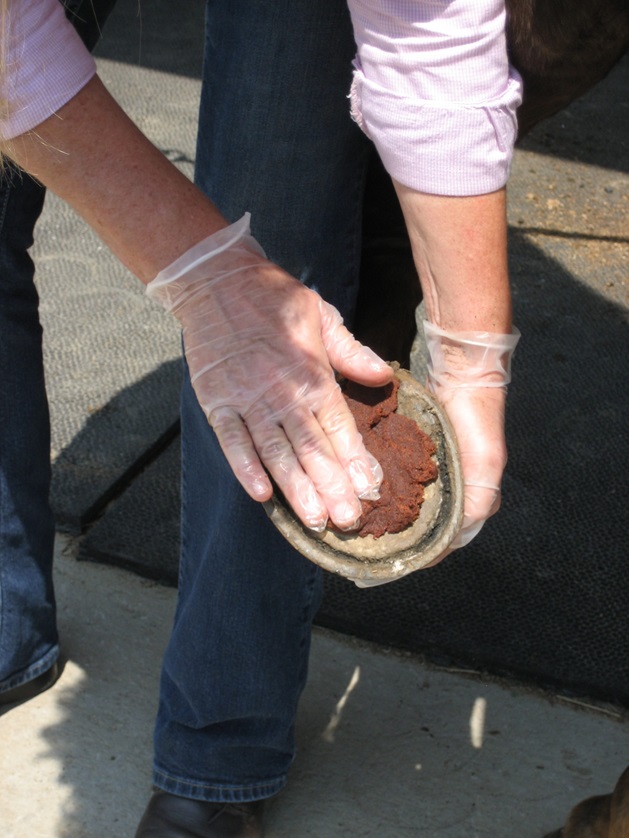Horses may be big, and due to this we view them as powerful animals that can take on a lot of the tasks you hand them over (whether racing or farm work), but they do require adequate care with the right supplies and steps. This is especially true for their hooves, as they go through a lot of wear and tear on a daily basis. With this in mind, hoof packing deserves to be part of the basic care routine.
What is Hoof Packing?

It’s simply the application of suitable hoofpack materials to the hoof’s sole and frog area. This simple step of care is essential not only in treating certain hoof issues like sensitivity, soreness, bruising, or worse – abscesses, but also comes in handy with preventing the said issues. This is due to the packing being perfect for offering support and comfort for the soles, as much as relief and healing.
Some horses need this type of care more than others. This includes those with thin or sensitive soles, those with brittle hooves, those that are prone to foot sores, and those that are going from wearing shoes to barefoot. Also, don’t forget about horses doing heavy work several days in a row (including competing), and horses riding on hard surfaces.
Tips for Effective Hoof Packing
To make sure you do this care properly and get the wanted results, it’s crucial to consider the following aspects:
Hoof Packing Supplies
As there are different options of hoofpack supplies on the market, ranging in price as much as ingredients (e.g. silicone, pine tar, epsom salts, iodine, tea tree, clay, poultice) and form, it’s necessary to consider what it is you’re doing the packing for.
Cushioning
If it’s for reducing inflammation, hoof heat, or pulling out bruising, soft consistencies like the FootPro DIM20, or Absorbine Hooflex Magic Cushion can provide the cushioning the soles need. They’re easy to form and add to the sole of the hooves.
Drawing Toxins
In the case of abscesses, or bruises as well, you can rely on poultices like those with epsom salts that can be smoothed into the hooves (specifically the soles and the frogs). Unlike the previous type of product, these don’t add cushioning, but are helpful with drawing out toxins and reducing inflammation.
Treating Infections
If it’s for treating infections from bacteria or fungi, then you should acquire clays. Besides being useful for treating this kind of issue with success, as clays can be added even into cracks, they’re also great as a preventative measure to avoid such issues in the first place.
Other Essentials

To avoid any mess, make for easy application and effective treatment, be sure to include the following supplies in your list of essentials too:
Gloves
It’s helpful to wear the gloves when preparing the supplies of hoof packing for horse to be certain you apply the product on the hooves properly, and also reduce the amount of mess to clean up afterwards.
Diaper
It may not seem helpful but it can be just the thing you need to make sure the product stays put and acts on the abscess, for example.
Bandage Wrap
To keep the packing and diaper from falling out, don’t forget to count on the help of bandages too.
Duct Tape
This is a must to hold the wrap or add another layer of bandage.
Hoof Tape
To smooth the adhesive edges right against the hoof wall, and be certain the product would start to work its magic, count on these tapes specifically made for the hooves. They’re easy to stick to the bottom of the hooves.
Hoof Wrap
Besides ensuring the product stays in place, along with the layers of diaper, wraps and tapes, this specific hoof wrap can be of use with adding a dose of padding to the treated hooves.
Boot
Perfect for various occasions, like both when your horse is in the stable and when its outdoors, the boot can secure the packing materials, as well as keep the hooves clean and dry.
Hoof Packing Steps
Considering the size of horses, it may not be the simplest job to do but it’s nothing a little planning and preparedness can’t do. To make the whole process smoother and faster, easier for both you and the animal, it’s advisable to have all the supplies you need within reach.
As you’d be doing the packing, it’s best to have someone help you out with keeping the horse still. Pick out a clean and dry area, prep the supplies (like cutting the needed size of tape), and clean the horse’s feet to get rid of any dirt, debris, or shavings.
Follow up with applying the necessary hoofpack product, then add the cover (e.g. the diaper) to protect the product and hoof. Finish up with the wrap and the tape to secure everything. Let the product work 12 hours at a time to ensure you get the wanted results. Since it’s a long period, it’s best to do so when the horse is in the stable overnight. If necessary as treatment, and not as prevention, repeat the process for several days.


